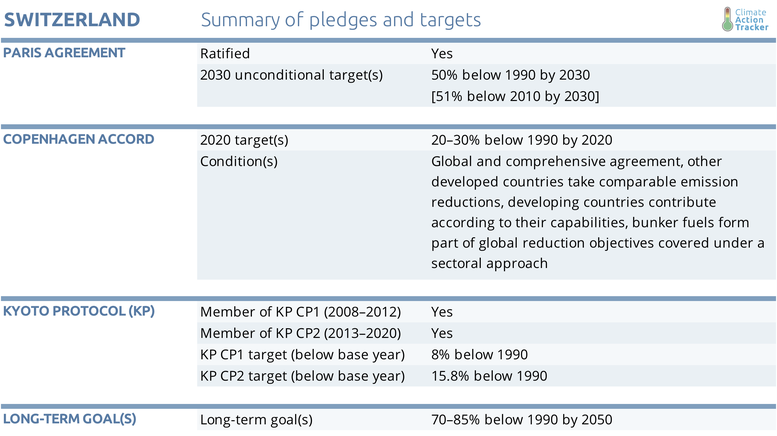Pledges And Targets
Summary table

Paris Agreement target
The Swiss government ratified the Paris Agreement in 2017. Its NDC commits Switzerland to an emissions reduction of 50% by 2030. It anticipates an emissions reduction of 35% below 1990 levels by 2025. The recommendation from the Federal Council is that at least 30% is to be achieved domestically, and the rest through emissions reductions abroad (Bundesamt für Energie, 2016).
Like the EU’s NDC, Switzerland’s NDC includes LULUCF, for which the details of the accounting rules have yet to be decided. The NDC states the wish to use a reference level for forest land, while emissions for other land uses will be included in both the target and baseline years. If we simply assume that the accounted LULUCF emissions in 2030 are the same as the projected LULUCF emissions (i.e. the forest reference level would be set at zero), this would result in about 1MtCO2e; the impact of LULUCF is negligible for Switzerland.
Switzerland intends to use carbon credits from international mechanisms (Clean Development Mechanism, as well as new market mechanisms under the Convention, such as NMM and activities under the FVA), and states it will apply quality criteria that are at least in line with those of Switzerland’s current national legislation.
2020 pledge and Kyoto target
Switzerland agreed to sign up to the Kyoto Protocol for a second commitment period (2013–2020), as proposed at the COP 18 in Doha. Switzerland submitted a QELRO1 level of 84.2, meaning its average yearly emissions for the period 2013–2020 will be 84.2% of 1990 levels.
Switzerland's commitment under the Convention (Copenhagen Pledge) for 2020 is to reduce emissions by between 20% and 30% below 1990 level. While the 20% reduction commitment is unconditional, the 30% is conditional on a global and comprehensive climate agreement. According to Switzerland’s submission, such an agreement would include other developed countries pledging comparable emissions reductions, and developing countries contributing according to their capabilities. In its 6th National Communication Switzerland restated the 20% reduction commitment, with the possibility that this “could be increased up to 30%”.
1 The quantified emission limitation and reduction objectives (QELRO), expressed as a percentage in relation to a base year, denotes the average level of emissions that an Annex B Party could emit on an annual basis during a given commitment period
Long-term goal
Switzerland’s NDC contains an indicative long-term goal to reduce emissions by 2050 to 70%–85% below 1990 levels by 2050, including use of international credits.
Further analysis
Latest publications
Stay informed
Subscribe to our newsletter




